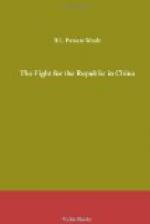The situation had, however, developed so far and so rapidly that this expression of opinion had little weight. The Vice-President of the Republic, General Feng Kuo-chang, unwilling or unable to do anything, had already tendered his resignation from Nanking, declaring that he would maintain the “neutrality” of the important area of the lower Yangtsze during this extraordinary struggle; and his action, strange as it may seem, typified the vast misgivings which filled every one’s mind regarding the mad course of action which the rebellious camarilla had decided upon.
Until Saturday the 9th June, the President had seemed adamant. On that day he personally saw foreign press correspondents and assured them that, in spite of every threat, he would in no conceivable circumstances attempt the unconstitutional step of dissolving Parliament,—unconstitutional because the Nanking Provisional Constitution under which the country was still governed pending the formal passage of the Permanent Constitution through Parliament, only provided for the creation of Parliament as a grand constitutional Drafting Committee but gave no power to the Chief Executive to dissolve it during its “life” which was three years. As we have already shown, the period between the coup d’etat of 4th November, 1913, and the re-convocation of Parliament on 1st August, 1916, had been treated as a mere interregnum: therefore until 1918, if the law were properly construed, no power in the land could interrupt the Parliamentary sessions except Parliament itself. Parliament, in view of these threatening developments, had already expressed its willingness (a) to re-consider certain provisions of the draft constitution in such a conciliatory manner as to insure the passage of the whole instrument through both houses within two weeks (b) to alter the Election Law in such fashion as to conciliate the more conservative elements in the country (c) to prorogue the second session (1916-1917) immediately these things were done and after a very short recess to open the third session (1917-1918) and close it within three months allowing new elections to be held in the early months of 1918,—the new Parliament to be summoned in April, 1918, to form itself into a National Convention and elect the President for the quinquennial period 1918-1923.
All these reasonable plans were knocked on the head on Sunday, the 10th June, by the sudden report that the President having been peremptorily told that the dissolution of Parliament was the sole means of saving the Republic and preventing the sack of Peking, as well as an open armed attempt to restore the boy-emperor Hsuan Tung, had at last made up his mind to surrender to the inevitable. He had sealed a Mandate decreeing the dissolution of Parliament which would be promulgated as soon as it had received the counter-signature of the acting Premier, Dr. Wu Ting-fang, such counter-signature being obligatory under Article 45 of the Provisional Constitution.




